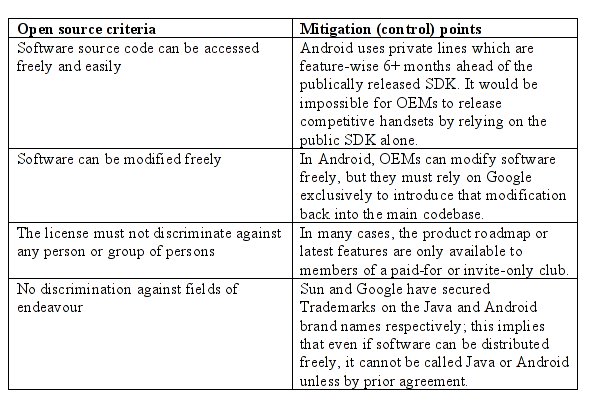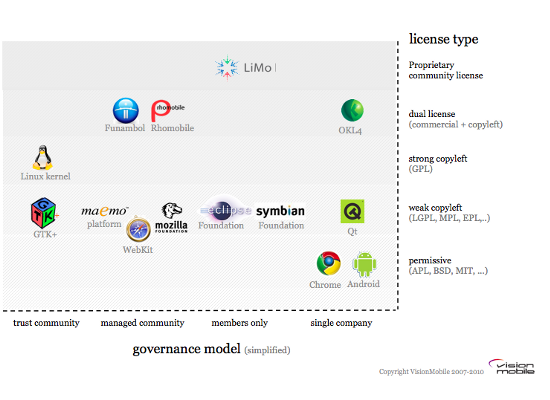"Open source licenses tell only half the story. The governance model, the implicit rules defining transparency and influence into an open source project, is the small print that determines the power dynamics around that project."
Andreas Constantinou
Openness is a much-misunderstood word. It represents a kind of good-will moniker to which people attach an impressive variety of definitions: open source code, open standards, open handsets, openness as in transparency, shared roadmaps, open application programming interfaces (APIs), open route to market, and so on. It is a very forgiving term as far as definitions go.
One of the mobile industry's favourite facets of openness is open source code. Since 2007, tens of mobile industry giants and consortia have embraced open source in some form or other: the Symbian Foundation, LiMo Foundation, Google's Android, Nokia's Qt, Apple's WebKit and Nokia+Intel's Meego are the initiatives that have hit the industry front pages. On the surface, these initiatives use open source licenses, but that only tells half the story. Behind the scenes, Google, Apple, Nokia and others use restrictive governance models and control points that effectively detract the very freedoms that open source licensing is meant to bestow. This article discusses the many forms that governance models can take, and how they are used in the mobile industry to tightly control the roadmap and application of open source projects.
What is Open Source?
Open source licensed software carries four basic freedoms that provide the right to access, modify, distribute and contribute to the software. These freedoms have been expanded into ten cardinal points that form the criteria that every open source license must adhere to, and which are defined by the Open Source Initiative.
A handful of different licenses are used in the vast majority of open source projects; namely the GPL, LGPL, APL, EPL, MPL, BSD and MIT. Interestingly, the GPL which is known as a strong copyleft license, is most often used in personal computer and Internet projects, but is rarely used in the mobile industry. Instead, the licenses used most often in mobile software are weak copyleft, such as the EPL, or permissive licenses, such as the APL, due to handset manufacturer concerns for downstream liabilities.
Licenses are Half the Story
What's often missed in open source discussions is how open source licenses tell only half the story. The governance model, the implicit rules defining transparency and influence into an open source project, is the small print that determines the power dynamics around that project.
In practice, mobile open source initiatives use a variety of control points - such as trademarks, private lines, distribution of derivatives, ownership of reviewers, gravity of contributions and contributor agreements - to turn an egalitarian governance model into an authoritarian one. Such control points can detract the very freedoms that open source licenses are meant to bestow, examples of which are shown in Table 1.
Table 1: Control Points Used in "Open" Mobile Projects

In general, open source licenses pertain to the use of the source code in a purist sense, while governance models relate to the use of a product in a practical sense. Governance models are much more fundamental in determining the ecosystem dynamics around that product.
Mapping Licenses vs. Governance Models
Governance models can be simplified to indicate the democracy of transparency and influence on an open source product. On one end of the spectrum are autonomous trust communities where opinion leaders influence the direction of the product through a chain of trusted reviewers. An example of this type of model is Linux. On the other end are single-sponsor communities where the product roadmap, private lines, contributions and trademarks are controlled by a single company. Based on this simplified governance model, we map the most popular mobile open source projects, as seen in Figure 1.
Figure 1: Licenses vs Governance Models

The picture that emerges is one where:
-
open source licenses (the large print that covers source control) are widely used, converged and well understood, while
-
governance models (the small print that governs product control) are proprietary, diverging and poorly understood
The Maze of Governance Models
There have been many attempts at classifying governance models, but there is really no universal dictionary, no certification body, and an excessive amount of open marketing hype to help obscure rather than enlighten the mobile industry. This is further exacerbated by the fact that governance model particulars are usually available under confidentiality terms. They are rarely critisized and debated in public, in the way, for example, an intrusive privacy policy would be.
How do open source initiatives control access to a product, manage influence mechanisms, or intellectual property (IP) rights for contributions? We have attempted to provide some of the key questions that should be asked when determining the level of openness of a governance model:
-
Is the latest source code publically available or are feature-packed private codelines available discriminately to selected parties?
-
Is the product roadmap publically available or to members only?
-
How is the roadmap formed and who has voting rights?
-
Is there a transparency of contributions in terms of the level and type of contributions by partipating companies?
-
Is the amount of contributors and reviewers/maintainers balanced among the community or does one company form the gravity centre of contributions?
-
Can anyone become a code reviewer or maintainer? (upstream influence)
-
Can contributions be deemed as mandatory? (downstream influence)
-
Are derivatives available widely, or through a proprietary route to market, such as seen in the Android Market?
-
Can you fork the software and buy the service from somewhere else?
-
Is there a trademark applying to the use of the project name and embodiments of products?
-
Do contributions require copyright assignment or patent grants?
-
Are there any safe harbour provisions for contributors to the source code?
We believe that governance models are the key determinant of the ecosystem dynamics, and the level of innovation around open source projects.
A Call for Education
What the mobile industry needs is not more marketing hype around the benefits of openness, but more education and clarity on governance models. The industry also needs a benchmark - a sort of openness index - for determining the true dynamics of an open source product, and for pushing the corporate sponsors to play fair. At VisionMobile we have been quietly working towards developing an openness index and are keen to hear from companies who want to make this happen.
Governance is one of the most understated topics in the open mobile industry today, yet one of the most fundamental in the direction the industry will be taking.
